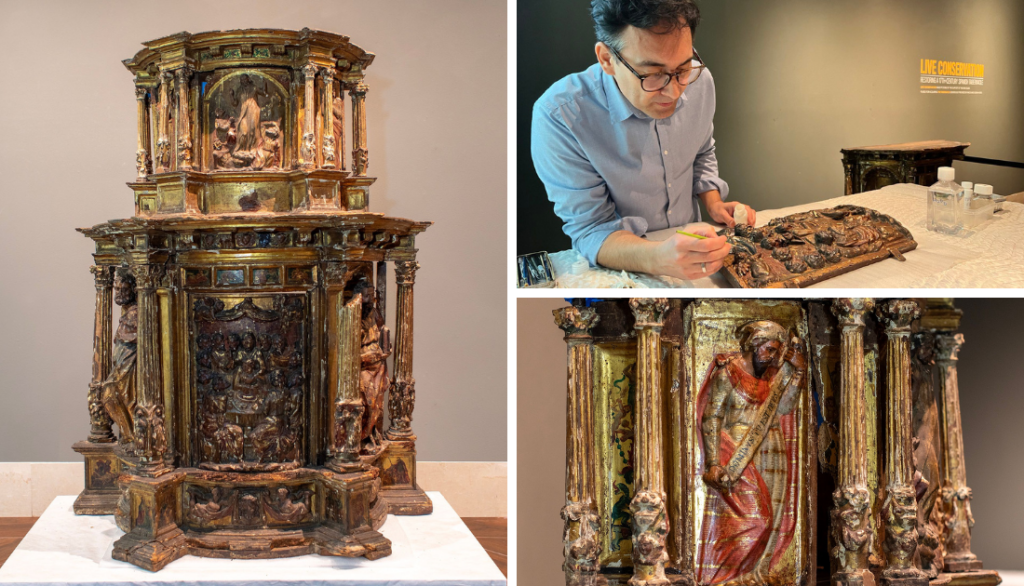
Live ConservationRestoring a 17th Century Spanish Tabernacle
March 16 through June 23, 2024
The conservation of art—preserving objects through professional, specialized treatment—is one of the Museum of Fine Art’s most important goals. This small, intensive exhibition focuses on the conservation of a gilded, painted, and carved tabernacle made in Northern Spain during the mid-1600s. This extraordinary object, which the museum recently acquired, preserves most of its original surface. However, over time, woodworms, daily use, and even changes in humidity and temperature have damaged the work. In addition, dust, candle soot, and other contaminants have dulled the rich gilded and painted surfaces.
Over the coming months, Luis Seixas—an alumnus of the conservation program at the prestigious Universidade Nova, Lisbon—will meticulously undertake the task of cleaning, consolidating, and restoring this precious artifact live within the Miriam Acheson Gallery.
Among the most important goals of modern conservation is assuring that any alteration—including repairs or repainting—returns the object as much as possible to its original appearance. This unique experiential project will allow visitors to see the conservation process and interact with the conservator—allowing them to ask questions about treatment, technique, and materials.
The exhibition will also explore the tabernacle’s fascinating historical context and complicated symbolism. The work’s golden surfaces reflect the riches Spain plundered from the Americas, while its elaborate architectural form suggests the glories of Baroque architecture. The paintings and carvings across the tabernacle’s surface—ranging from the Old Testament Prophets Elijah and Moses to The Transfiguration of Christ—were intended to reinforce the importance of the Christian faith and the Church of Rome. Combining live conservation with history and art history, this project is a rare chance to experience behind-the-scenes museum work. It is also an excellent opportunity to see the Museum bringing to life our mission of engaging, educating, and exciting the community by collecting, exhibiting, and preserving works of art for the enjoyment of all.
Live conservation will occur most weekdays (Tuesday through Friday) between 10 am – 2 pm, with a break around noon. Special Saturday sessions will be as follows:
Saturday, April 6
10:00 am – 12:00 pm
Saturday, May 4
10:00 am – 12:00 pm
Saturday, June 1
10:00 am – 12:00 pm
LIVE CONSERVATION MADE POSSIBLE BY THE MFA GUILD.
Formerly known as the Collectors Circle, a dedicated support group of the Museum of Fine Arts, St. Petersburg since 1995, the MFA Guild brings together collectors, benefactors, and art enthusiasts. Members of the MFA Guild enjoy exclusive benefits, including special trips, educational experiences, and unique fundraising opportunities to further support the museum. The primary aim of this group is to enhance the MFA Collection through art acquisition and collections care. The Museum is profoundly thankful for the contributions of the MFA Collectors Circle, whose philanthropic generosity has enriched the MFA Collection with 41 works of art spanning various periods, styles, and media.